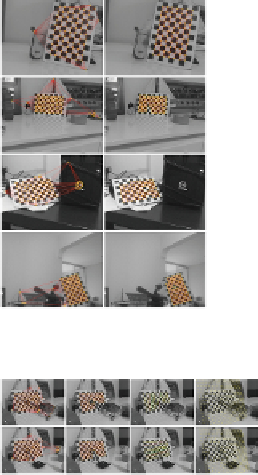Image Processing Reference
In-Depth Information
FIGURE 8
Example of images used in the second test. The left column shows all x-corners
and the triangulation. The right column shows the topological filter result.
FIGURE 9
Results with complex backgrounds and partial occlusion.
7 Conclusions
This work proposes a methodology for automatic detection of chessboard calibration paterns.
The algorithm runs automatically without any user intervention. It can detect the calibration
points both in simple and complex background scenes where the calibration points mix with
other image characteristics. The proposed methodology is robust to the presence of noise and
also when the patern cannot be fully identiied. A partial identiication of the pattern allows
the calibration process to consider the max of detected points. In conditions where few points
are available most picture frames are utilized.
References
[1] Hartley R, Zisserman A.
Multiple view geometry in computer vision.
2nd ed. New York:
Cambridge University Press; 2003.0521540518.
[2] Trucco E, Verri A.
Introductory techniques for 3-D computer vision.
Upper Saddle River,
NJ: Prentice Hall PTR; 1998.0132611082.
[3] Duta A, Kar A, Chaterji BN.
A novel window-based corner detection algorithm for gray-
scale images.
In: Sixth Indian conference on computer vision, graphics & image pro-
cessing, ICVGIP'08; Washington, DC: IEEE Computer Society; 2008:650-656. Avail-
cessed September 15, 2012].
[4] Chen D, Zhang G.
A new sub-pixel detector for x-corners in camera calibration targets.
In: 13th international conference in central Europe on computer graphics, visualiza-
tion and computer vision, Winter School of Computer Graphics (WSCG-short papers)'
2005, Václav Skala - UNION Agency, University of West Bohemia. Plzen; Czech Re-

Search WWH ::

Custom Search